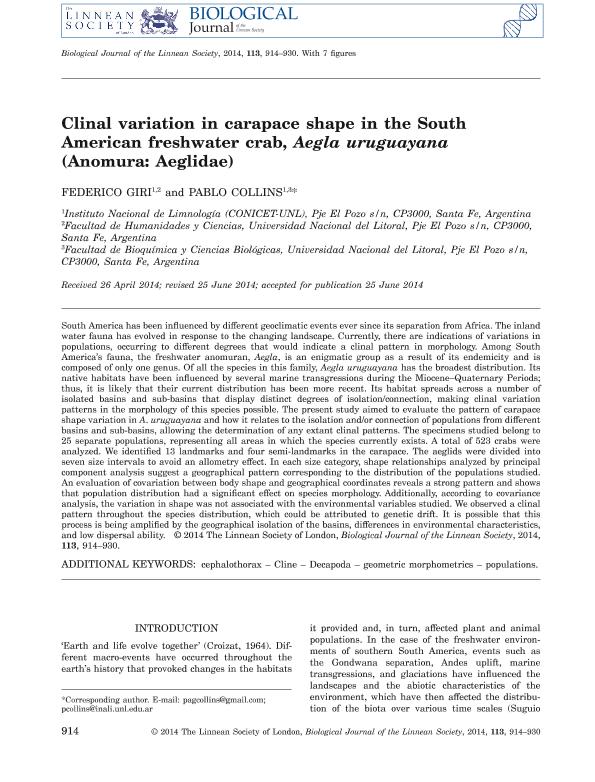Artículo
Clinal variation in carapace shape in the South American freshwater crab, Aegla uruguayana (Anomura: Aeglidae)
Fecha de publicación:
11/2014
Editorial:
Oxford University Press
Revista:
Biological Journal of The Linnean Society
ISSN:
0024-4066
Idioma:
Inglés
Tipo de recurso:
Artículo publicado
Clasificación temática:
Resumen
South America has been influenced by different geoclimatic events ever since its separation from Africa. The inland water fauna has evolved in response to the changing landscape. Currently, there are indications of variations in populations, occurring to different degrees that would indicate a clinal pattern in morphology. Among South America's fauna, the freshwater anomuran, Aegla, is an enigmatic group as a result of its endemicity and is composed of only one genus. Of all the species in this family, Aegla uruguayana has the broadest distribution. Its native habitats have been influenced by several marine transgressions during the Miocene–Quaternary Periods; thus, it is likely that their current distribution has been more recent. Its habitat spreads across a number of isolated basins and sub-basins that display distinct degrees of isolation/connection, making clinal variation patterns in the morphology of this species possible. The present study aimed to evaluate the pattern of carapace shape variation in A. uruguayana and how it relates to the isolation and/or connection of populations from different basins and sub-basins, allowing the determination of any extant clinal patterns. The specimens studied belong to 25 separate populations, representing all areas in which the species currently exists. A total of 523 crabs were analyzed. We identified 13 landmarks and four semi-landmarks in the carapace. The aeglids were divided into seven size intervals to avoid an allometry effect. In each size category, shape relationships analyzed by principal component analysis suggest a geographical pattern corresponding to the distribution of the populations studied. An evaluation of covariation between body shape and geographical coordinates reveals a strong pattern and shows that population distribution had a significant effect on species morphology. Additionally, according to covariance analysis, the variation in shape was not associated with the environmental variables studied. We observed a clinal pattern throughout the species distribution, which could be attributed to genetic drift. It is possible that this process is being amplified by the geographical isolation of the basins, differences in environmental characteristics, and low dispersal ability.
Palabras clave:
Cline
,
Aeglidae
,
Southern South America
,
Populations
Archivos asociados
Licencia
Identificadores
Colecciones
Articulos(INALI)
Articulos de INST.NAC.DE LIMNOLOGIA (I)
Articulos de INST.NAC.DE LIMNOLOGIA (I)
Citación
Giri, Federico; Collins, Pablo Agustin; Clinal variation in carapace shape in the South American freshwater crab, Aegla uruguayana (Anomura: Aeglidae); Oxford University Press; Biological Journal of The Linnean Society; 113; 4; 11-2014; 914-930
Compartir
Altmétricas




